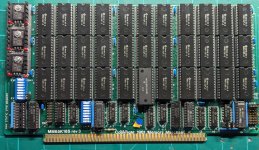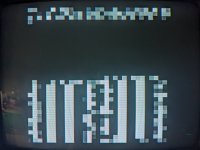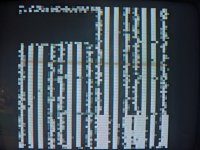daver2
10k Member
Sorry, I mean 0000 0000.
You should get what is in post #785.
Dave
You should get what is in post #785.
Dave
Incidentally, I just received my batch of NOS TI 157's and swapped out all 4. No change in behavior though..In a bit of spare time, can you double check the 157 and 175 ICs on board #1 are correct.
A long shot...
Dave
Previously I thought there was because of the way the color encoder works, it is not a suppressed color carrier system as in standard NTSC video, is and in color mode, there is always residual color carriers seen on the video signal even if the balance of them results in what looks like a white or shade of grey.This makes me think we have a problem further down the Dazzler logic, but it will be easier to diagnose this problem with a working RAM board...
Dave
Yes that is still the case.Providing we have a completely white screen with my test program running and with D7 to D0 all 0 (the default) we are good to go...
Most of the IC's are socketed, but several of the 74LS chips along the bottom are soldered in. I don't mind making minor mods to this board, I have 3 othersI also have a plan for your memory board, if you don't mind bending a pin out of a socket and applying a shorting link. Are all the ICs in sockets?

- Seattle Computer 16k standard RAM card
- Compupro RAM-17
74S devices are four times faster than standard 74 devices and draw slightly more current.
No question - the CompuPro RAM17. It's design (like the SCP 16K board) uses the least number of parts, and S100 signals, required for an S100RAM board to work. Both the RAM17 and SCP 16K board currently sell for a similar price on the used market. However the advantage clearly goes to the RAM17 which, on a single board, provides all the RAM that a Z80 system can make use of.I do have a lot of faith in Dave's ingenuity - but just in case I had to acquire another RAM board, which would you think between these two? I'd like to be to run all the available Dazzler software - I'd be concerned a single 16K board wouldn't be enough for CDOS + the software.
Thanks! Unfortunately Mike D's all sold out of his lot. Will keep an eye out just to have as a backup.No question - the CompuPro RAM17. It's design (like the SCP 16K board) uses the least number of parts, and S100 signals, required for an S100RAM board to work. Both the RAM17 and SCP 16K board currently sell for a similar price on the used market. However the advantage clearly goes to the RAM17 which, on a single board, provides all the RAM that a Z80 system can make use of.
Generally I agree, though there was one thing that made the 64k SCP-110A better for me than the Compupro RAM-17, I needed to deactivate a memory window over 6000h to 7FFFh, I was able to do it by programming an OTP ROM., for the SCP card. I did it with no permanent mods to the SCP card, by running wires then even a tiny screw through existing plated through holes. The card has very attractive INMOS memory IC's on it, and it would be a shame to modify it. I bought a few tubes of those IC's so I had enough for a whole spare set. I needed that memory range knocked out for my Bytesaver board and in that I put BASIC-5 in the ROMs and used a block move program to shift the entire program to start at 0000h, where the program was coded to run and that BASIC version I think uses up memory to nearly 6000h.No question - the CompuPro RAM17. It's design (like the SCP 16K board) uses the least number of parts, and S100 signals, required for an S100RAM board to work. Both the RAM17 and SCP 16K board currently sell for a similar price on the used market. However the advantage clearly goes to the RAM17 which, on a single board, provides all the RAM that a Z80 system can make use of.
Hi,Thanks! Unfortunately Mike D's all sold out of his lot. Will keep an eye out just to have as a backup.
I think you meant IC 9C, right?Bend pin 16 (/DATA STB) out of IC 6C (82S100).
Yep, RDOS runs and passes the memory test. Just for the heck of it I wanted to see what your test app looks like..Plug the memory card back in and make sure RDOS still works. Run the RDOS memory test to make sure.


